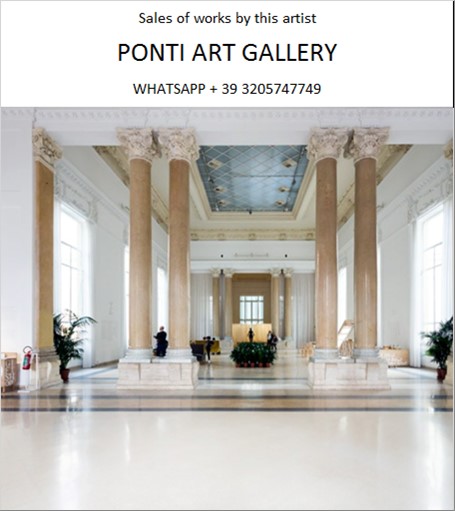Ponti Art Gallery is interested in buying and selling works
of art by this artist.

Georges Braque Biography
Georges Braque was a seminal figure in the development of modern art in the 20th century, whose innovative approaches to painting and sculpture played a pivotal role in the evolution of Cubism. Born on May 13, 1882, in Argenteuil, Val-d'Oise, France, Braque grew up in Le Havre and initially trained to be a house painter and decorator, following in the footsteps of his father and grandfather. However, his passion for art led him to pursue serious painting studies during the evenings at the École des Beaux-Arts in Le Havre from about 1897 to 1899.
In Paris, Braque apprenticed with a decorator and earned his certificate in 1902. The following year, he attended the Académie Humbert, where he painted until 1904 and met artists such as Marie Laurencin and Francis Picabia. Braque's early works were impressionistic, but after witnessing the bold works of the Fauves in 1905, he adopted a Fauvist style. The Fauves, including Henri Matisse and André Derain, were known for their use of vibrant colors and loose structures to convey emotional intensity. Braque worked closely with artists Raoul Dufy and Othon Friesz, who shared his hometown of Le Havre, to develop a more subdued Fauvist style.
Braque's artistic direction took a significant turn after the 1907 Cézanne retrospective at the Salon d'Automne, which had a profound impact on the avant-garde in Paris and led to the advent of Cubism. From 1908 to 1913, Braque's work began to reflect his new interest in geometry and simultaneous perspective. He conducted an intense study of the effects of light and perspective and the technical means that painters use to represent them, often questioning conventional artistic methods. In his village scenes, for example, Braque frequently reduced architectural structures to geometric forms approximating cubes, yet rendered them with shading that made them appear both flat and three-dimensional.
In 1909, Braque began to work closely with Pablo Picasso, who had been developing a similar approach to painting. Their collaboration was so intimate that their respective Cubist works were virtually indistinguishable for a time. Together, they developed both Analytical and Synthetic Cubism, revolutionizing the way artists approached form, space, and composition. Braque's notable works from this period include "Houses at L'Estaque" and "Violin and Candlestick."
During World War I, Braque served in the French army and was severely wounded in 1915. After a long convalescence, he returned to painting, moving away from the strict geometries of Cubism towards a more personal style characterized by looser drawing and freer brushwork. His post-war art featured still lifes with a serene and meditative quality, often incorporating elements of his earlier Cubist style.
Braque's contributions to art were not limited to painting; he also worked in sculpture, printmaking, and even stained glass. His first significant retrospective took place in 1933 at the Kunsthalle Basel, and he won first prize at the Carnegie International in Pittsburgh in 1937. Throughout his career, Braque's work continued to evolve, and he experimented with various themes and motifs, including birds, landscapes, and the sea.
Despite his innovations and collaborations, Braque was often overshadowed by the more flamboyant Picasso. Nevertheless, his quiet nature and dedication to his craft earned him a respected place in the history of art. Braque continued to paint, make lithographs, and design jewelry until his death on August 31, 1963, in Paris. His legacy is preserved in major museums worldwide, and his influence on subsequent generations of artists remains profound. Georges Braque is remembered not only as a master of Cubism but also as an artist who constantly sought to challenge and expand the boundaries of visual representation.
Georges Braque Quotes and
Sales of Works
Ponti Art Gallery selects and deals with paintings by the
artist. Upon request, we provide free estimates and
evaluations, communicate prices, quotations, and current
market values.
If you are interested in BUYING or SELLING works by the
artist, contact us immediately.
If you wish to sell or receive an evaluation of the
works:
Send us a frontal photo of the painting, one of the back,
and one of the signature. Also, indicate the dimensions of
the work. Inform us about the purchase origin of the work
and any kind of available documentation (purchase
receipts, certificates of authenticity, publications). One
of our operators will respond to you on the same day. We
guarantee maximum confidentiality and extreme
professionalism.
If you wish to purchase works by the painter: Contact us
and let us know your request. We will inform you about the
available works. We also offer the possibility to
subscribe to our NEWSLETTER, through which you will be
informed at the beginning of each month about the latest
acquisitions of the art gallery.
You can send us pictures of the work:
